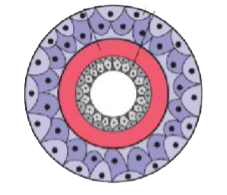Contrast the development of protostomes and deuterostomes in three ways. List the phyla which belong to each group.
To contrast the development of protostomes and deuterostomes, we can identify three key differences and list the phyla that belong to each group.
1. Development of the Blastopore:
- In protostomes, the blastopore (the first opening that forms during embryonic development) develops into the mouth.
- In deuterostomes, the blastopore develops into the anus.
2. Cleavage Pattern:
- Protostomes exhibit a spiral cleavage pattern during early embryonic development. This means that the cells divide at an angle, resulting in a spiral arrangement.
- Deuterostomes exhibit a radial cleavage pattern, where the cells divide parallel or perpendicular to the axis of the embryo, resulting in a more organized, radial arrangement.
3. Nervous System Structure:
- In protostomes, the nerve cord is solid and located in a ventral position (the belly side).
- In deuterostomes, the nerve cord is hollow and located in a dorsal position (the back side).
Phyla Examples:
- Protostomes include:
- Arthropoda (e.g., insects, crustaceans)
- Annelida (e.g., earthworms, leeches)
- Deuterostomes include:
- Echinodermata (e.g., starfish, sea urchins)
- Chordata (e.g., mammals, birds, reptiles, amphibians, and fish)
Summary:
To summarize, the main differences between protostomes and deuterostomes are:
- The fate of the blastopore (mouth vs. anus).
- The pattern of cleavage (spiral vs. radial).
- The structure and position of the nerve cord (solid ventral vs. hollow dorsal).
- In protostomes, the blastopore (the first opening that forms during embryonic development) develops into the mouth.
- In deuterostomes, the blastopore develops into the anus.
- Protostomes exhibit a spiral cleavage pattern during early embryonic development. This means that the cells divide at an angle, resulting in a spiral arrangement.
- Deuterostomes exhibit a radial cleavage pattern, where the cells divide parallel or perpendicular to the axis of the embryo, resulting in a more organized, radial arrangement.
- In protostomes, the nerve cord is solid and located in a ventral position (the belly side).
- In deuterostomes, the nerve cord is hollow and located in a dorsal position (the back side).
- Protostomes include:
- Arthropoda (e.g., insects, crustaceans)
- Annelida (e.g., earthworms, leeches)
- Echinodermata (e.g., starfish, sea urchins)
- Chordata (e.g., mammals, birds, reptiles, amphibians, and fish)
To summarize, the main differences between protostomes and deuterostomes are:
- The fate of the blastopore (mouth vs. anus).
- The pattern of cleavage (spiral vs. radial).
- The structure and position of the nerve cord (solid ventral vs. hollow dorsal).
Topper's Solved these Questions
- ANIMAL KINGDOMBOOK - ICSECHAPTER - ANIMAL KINGDOMEXERCISE - Test Your Progress (HOTS)
11 Videos
- ANIMAL KINGDOMBOOK - ICSECHAPTER - ANIMAL KINGDOMEXERCISE - Ncert Exercises with Answers
15 Videos
- ANIMAL KINGDOMBOOK - ICSECHAPTER - ANIMAL KINGDOMEXERCISE - Test Your Progress (Very Short Answer Type Questions )
28 Videos
- ANATOMY OF FLOWERING PLANTS - PLANT TISSUESBOOK - ICSECHAPTER - ANATOMY OF FLOWERING PLANTS - PLANT TISSUESEXERCISE - REVIEW QUESTIONS (LONG ANSWER TYPE QUESTIONS)
20 Videos
- BIOLOGICAL CLASSIFICATIONBOOK - ICSECHAPTER - BIOLOGICAL CLASSIFICATIONEXERCISE - Ncert Exercises (Differentiate Between )
24 Videos
Similar Questions
Knowledge Check
Which of the following belongs to +I group ?
A−OHB−OCH3C−COOHD−CH3
In the periodic table, thallium belongs to which group
View SolutionMembers of which group are not deuterostomes?
View SolutionIn CuX2 , X belongs to which group?
View SolutionIn the periodic table, arsenic belongs to which group
View SolutionIn the periodic table, lead belongs to which group
View SolutionIn the periodic table, bismuth belongs to which group
View SolutionName all the noble gases and the group to which they belong to.
View Solution

